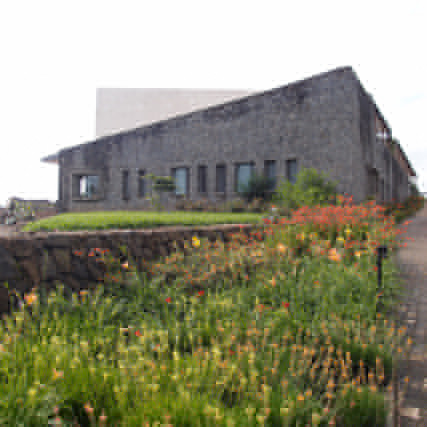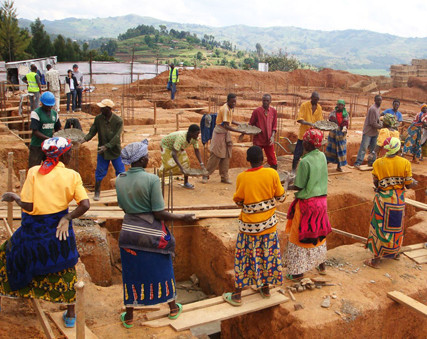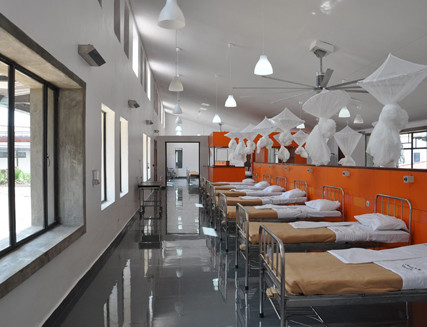The public interest design movement—which advocates that dignifying, beautifying, and healing design should not only be available to the elite—is, in many ways, shockingly young. The Rural Studio was founded in 1993, Architecture for Humanity in 1999, and Public Architecture, it’s domestic equivalent, in 2002. A couple of decades in, it’s exciting to see how a new generation of architects and designers are raising expectations for what this kind of work should look like and how it should affect everyday people’s lives.
One of the most interesting new organizations is MASS (Mobilizing Architecture to Serve Society), led by recent Harvard grads Alan Ricks and Michael Murphy. The pair, along with co-founder Marika Shioiri-Clark, now an IDEO.org fellow, built a 150-bed, 60,000-square-foot hospital in rural Rwanda last year with Paul Farmer’s Partners in Health. The Butaro Hospital was constructed by hundreds of local residents and, in the words of design advocate John Cary, writing in GOOD, “is breathtaking for its setting…design, and craftsmanship. It’s a job-creating, people-healing, field-innovating success story with origins in a most unlikely place.”
 The Butaro Hospital in rural Rwanda.
The Butaro Hospital in rural Rwanda.
MASS architects worked in collaboration with infectious disease specialists from Partners in Health and the Harvard Medical School to innovate new ways of laying out and naturally ventilating the hospital, in an effort to reduce the transmission of airborne disease. The design also made use of local materials—most notably, the volcanic rock from the Virunga Mountain Chain—reducing the cost of the hospital to roughly two thirds of what a hospital of this size would typically cost in Rwanda.
Murphy, who received the 2012 Designers of the Year Award from Contract Magazine, a design industry publication, took some time to speak about his work and how it’s progressing the public interest design movement:
Are you enjoying this article? Read more like this, plus SSIR's full archive of content, when you subscribe.
Courtney Martin: How is your approach different than previous humanitarian design interventions?
Michael Murphy: While our project is driven and inspired by “humanitarian” and “social” architects, what we learned in Rwanda is that all design has this potential—and architecture should be rated by humanitarian and social principles.
CM: The hospital in Butaro has been held up by many as a success. But success isn’t just about the product—the building itself—but about the process. What are you most proud of about the process that you and your collaborators pioneered?

MM: Building processes are usually not configured to serve communities in the most productive way possible. With Partners In Health, we decided to act locally to serve the community. We thought, How many local laborers could we hire? How many local materials could we use? The result was we hired 12,000 local people, and were able to customize nearly every piece of furniture, every window, and every door on site. That type of complete design has been lost in architecture, but it is completely available if we redesign the process of building.
CM: Buddhists talk about the value of “beginner’s mind”—being largely inexperienced so you don’t eliminate possibilities or accept the status quo. Do you see that quality of mind at work in MASS’ first undertaking?
MM: Of course we were completely naive about how to build a hospital, or even how to build an architecture firm. But that naïveté forced us to dive in, move to Rwanda, and really work closely with the doctors and the community to find the core issues this building needed to address. On the ground, we were able to ask, Can a hospital, the facility itself, also heal patients?
CM: I know you’ve been heavily influenced by radical architects of the past. Tell me a little bit more about that.
MM: There is a long and sometimes buried history of architects committed to articulating the socio-political impacts of design and architecture. Some of the Team Ten architects did this, but chief among them was Giancarlo De Carlo, who was deeply influential in this movement and has been largely forgotten.
CM: What have you learned from the local laborers that you’ve worked with?
MM: The results of hiring only local labor on the hospital project were profound. First, we found we could actually build cheaper and faster than if we’d been forced to import labor and machinery. The second thing we learned was that a locally built job force is like a giant educational and economic engine. We were able to customize much of the hospital, building furniture, details, and intricate stonework because of the close relationship with the laborers. It was a profound lesson that puts into question our increasingly prefabricated methodologies of construction in the U.S.
CM: What is the biggest challenge facing young architects and designers who want to do work for the public good?
MM: I think the most profound challenges are starting and sustaining a practice financially. The public good should, of course, be the goal of any architecture or design firm; however, funding vehicles don’t necessarily follow that logic. Young designers are finding their own strategies. Pro bono is one way. Sponsored research support from larger firms or universities is another. If they can fund a “proof of concept,” for example, often markets and new work follow. The more we can encourage this work, the more diverse and public-focused we can be.
CM: The connection between the homes and buildings we live, work, and heal in and our public health are finally become part of the public dialogue. What do you think is most important about this connection?

MM: Most important is that buildings are not objects, but systems that play a crucial role in providing the services they are meant to house. If we focus only on the “objectness” of buildings, we will fail to see the opportunities to make the building function and perform for its long-term goals. A good example of this can be found with ventilation and airflow. While building the hospital, we realized that too many buildings incubate and cultivate diseases that are killing people, so we focused a lot on designing so that fresh, clear air circulated. If buildings can kill, they can also heal, and our firm is focused on that as our principle mission.
CM: What’s next for MASS?
MM: MASS is getting involved in policy work at USAID, writing a primer for health facilities globally, finishing up a school in Rwanda, and an assessment of the health care delivery program of Cincinnati Children's hospital's Cerebral Palsy program.
Support SSIR’s coverage of cross-sector solutions to global challenges.
Help us further the reach of innovative ideas. Donate today.
Read more stories by Courtney E. Martin.

